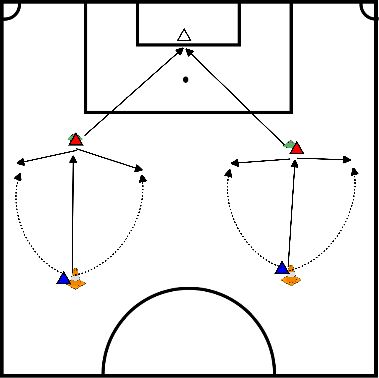Soccer drills for technique passing
- One ball per triplet
- Start with a distance of about 15 meters
- Two players on one side and one player on the other side.
- One of the players on the side with two plays the ball to the player on the other side, this player takes the ball and plays it to the player on the other side, and so on.
- Practice both with your good and lesser leg.
Variations:
- After a few minutes increase the distance, about 20, 25, 30 meters, at the 30 meters practice a lobster kick.
1st exercise:
- Player A plays the ball in to B and runs to B's position.
- Player B stands open turned, takes it and passes it to Player C and so on.
- Point of attention playing in:
- the ball must be hit in the middle so that it stays low.
- The correct technique for this is to lift your shooting leg slightly.
- Passing point:
- The player who accepts the ball should not be facing the ball with his or her body, but turned "open". You create this by positioning your body towards the player you are passing to and with your eyes on the ball.
- Playing around clockwise, the ball is taken on with the left and I play on with the right.
- In the other direction take on with the right and play on with the left.
- If you notice it's too easy, first increase the pace. Then to make it more difficult you can take out the assumption and they have to pass the ball directly.
2nd exercise:
- Player B asks for the ball.
- Player A plays into player B.
- Then B then drops the ball to player A after which he passes it back to player C.
- Player C then drops it to player B and then player B plays it diagonally to player D and so on.
Points of attention:
- The player who plays the ball in must move on after the play-in so that he can ask for the ball, in the middle, between the pawns
- Not further because then the effect is gone with the cross pass.
- The player who rebounds runs around his own pawn to ask for the ball again in the middle.
- This player must make the correct turn when rebounding so that he keeps his eyes on the ball.
- His turn should be short toward the box and not off the play.
In both drills after 8 minutes, change directions of play.
Clockwise passes with right leg, counterclockwise passes with left leg.
Clockwise passes with right leg, counterclockwise passes with left leg.
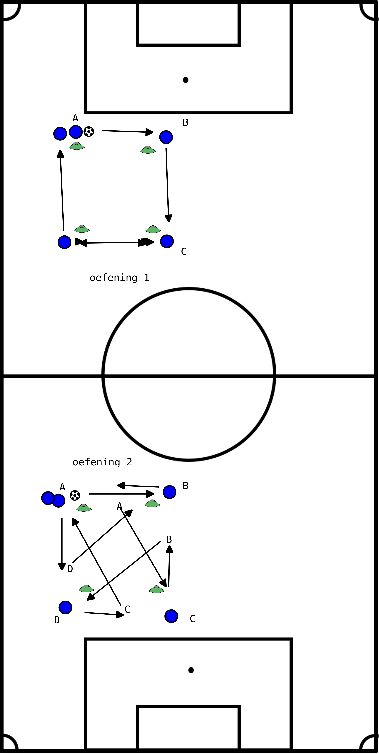
Square with 5 players or triangle with 4 players, at a distance of about 15 meters:
- Player at hat with 2 players starts.
- Plays the ball in on the right side and runs after his ball to the other hat.
- The player receiving the ball turns open and takes the ball well so that he can pass it in to the next player.
- Practice both counterclockwise and clockwise.
3 or 4 players per set:
- Two hats spaced about 15 yards apart.
- 2 players on one side and 1 or 2 players on the other side.
- 1 of the 2 players plays the ball to the other side and continues halfway to the other hat.
- The player on the other side takes the ball and plays it in to the player who ran halfway.
- This player rebounds the ball and continues to the other hat.
- The player who receives the ball back takes the ball and plays it to the player on the side where it was started.
- Running through like this.
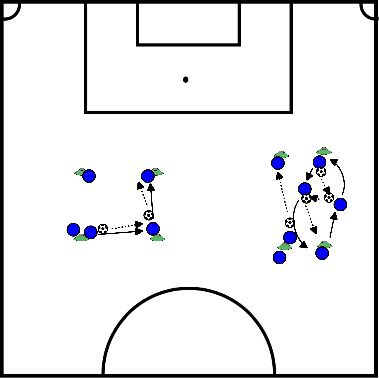
1st exercise:
- Player A plays the ball in to B and runs to B's position.
- Player B is open turned takes it and passes it to Player C and so on.
- Focal point 1 playing in: the ball must be hit in the middle so that it stays low.
- The correct technique for this is to lift your shooting leg slightly.
- Focal point 2 receiving: The player who has to receive the ball should not be facing the ball but rather, as they say, turned open. You create this by positioning your body towards the player you have to pass to and your face is facing the ball. Playing the ball around clockwise, the ball is taken on with the left and I play on with the right. other way round take on with the right and play on with the left.
- If you notice that it is too easy, first increase the tempo. If that also proves too easy then you take out the takeover and they have to pass the ball directly.
2nd exercise:
- Player B asks for the ball, player A plays into player B. Then B drops the ball to player A who then passes it on to player C.
- Player C then drops it to player B and then player B plays it diagonally to player D and so on.
Points of attention:
- The player who plays the ball in must move on after playing in so that he asks for the ball in the middle between the pawns
- Not further because then the cross pass effect is gone.
- The player who bounces the ball back runs around his own pawn to ask for the ball again in the middle.
- It is imperative that this player makes the correct turn when rebounding so that he keeps his eyes on the ball.
- His turn should be short toward the box and not off the play.
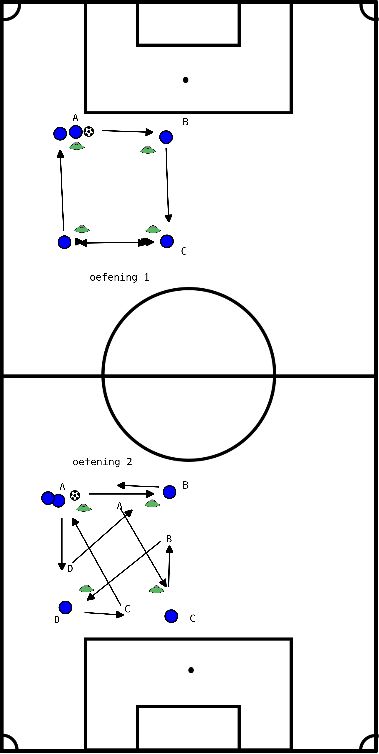
Goal:
Defenders try to intercept the ball quickly:
Exercise:
Defenders try to intercept the ball quickly:
Exercise:
- Play starts at number 6 who kicks to goalkeeper
- Goalkeeper then plays directly to 2 or 4
- At the moment 2 or 4 is played to, the blue team starts pressing and tries to prevent the depth pass
- The red team can "score" by passing a depth pass to number 6, who can move all over the width in his defined zone
- The blue team can score in the big goal
Coaching:
- 2-5 from defending side direct pressure on the ball
- 9 defending directly covers to line the ball
- 4 defending direct pass on number 5 attacking side.
- 6 attackers moving with ball and joining the game
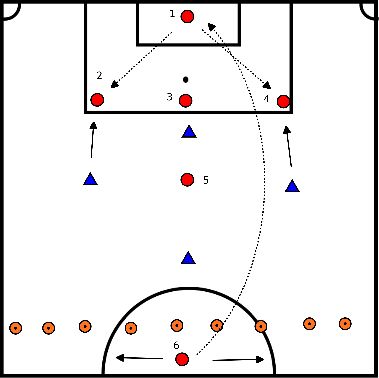
Goal:
Building up from behind in set patterns teach without resistance
Exercise:
Building up from behind in set patterns teach without resistance
Exercise:
- A plays on B
- B passes to A
- A dribbles a little, gives good ball to C
- C dribbles next hat
- C plays on D
- C runs on without ball
- D passes to C
- C works off
Changeover:
- A-B
- B-C
- C-D
- D retrieves ball - becomes A
Coaching:
- Movement without ball
- Good leg and tight passing
- Coach each other by calling out name
Playing style:
- 1-4-4-2
- A= 3-4
- B=6
- C=5
- D=9
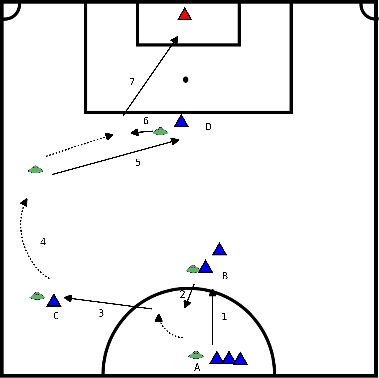
Goal of the exercise is to:
- Pass the ball into the boxes
- Score as many points as possible
- The opposing team's ball may be moved to another box by passing against it with the ball.
- In the youngest groups the distance from the green pawn to the scoring boxes is 5 meters, in the oldest groups it is 8 meters.
- The scoring boxes are 1 meter long and 3 meters wide.
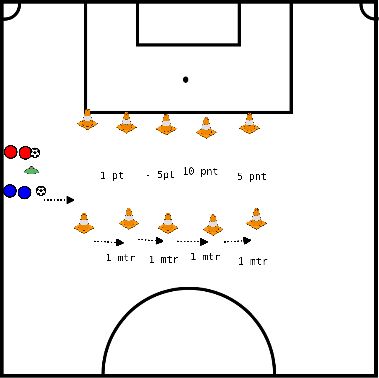
- Player gets the ball from trainer and kicks the cone on the left.
- Player gets the ball from trainer and kicks the cone on the right.
- Player gets the ball from trainer -> does a technique move and kicks from distance, cutting hard at goal.
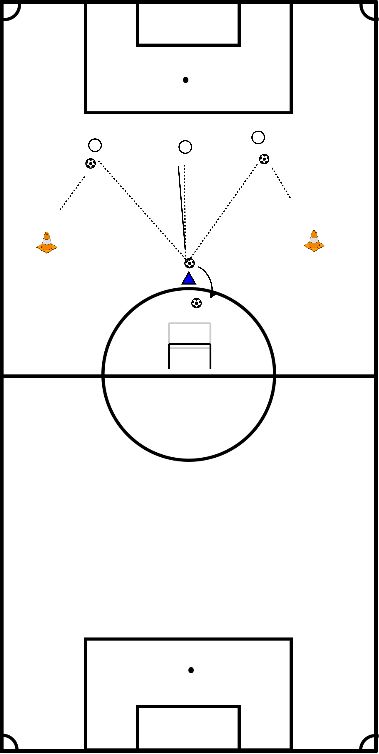
- 2 players face each other
- One is the sender the other the receiver
- The receiver receives and rebounds
- The receiver dribbles sideways several meters without the ball
- The receiver receives the ball again
- The receiver dribbles back without the ball
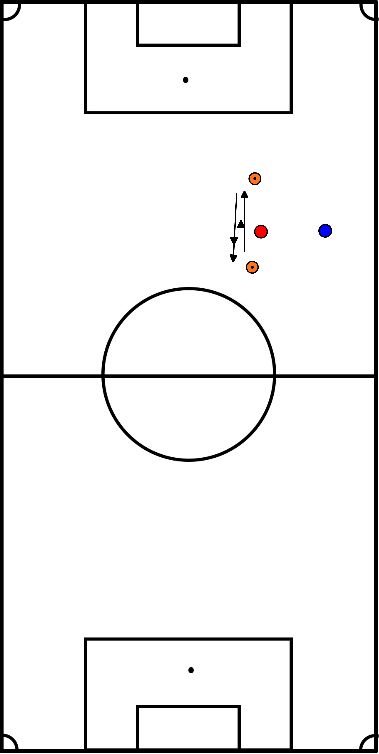
- Player 1 plays a long ball through the air to player 2.
- Player 2 receives the ball and then passes a long ball through the air to player 3.
- Player 3 places the ball ready for player 4.
- Player 4 passes a long ball through the air to the next player ready at Pylon A.
- Ball chasing at high pace for the conditioning stimulus.
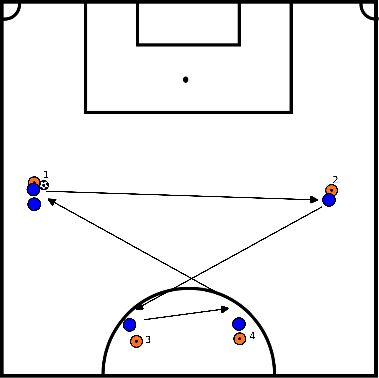
- The exercise starts with player A playing the ball in to the inquiring player B.
- Player B takes the ball and deposits it for the incoming player A, then offers himself to player C.
- Player A passes the ball to the inquiring player C, who in turn plays the ball in to the incoming player B.
- Once he passes the ball, he starts a run outside and goes to offer himself to player D.
- Player B takes the ball and passes it to the inquiring player D.
- Once player B has passed the ball, he starts a running action and offers himself in front of goal.
- Player D receives the ball and passes it back to the incoming player C.
- As soon as the ball is passed back, player D starts a run outside.
- There he receives the deep ball from player C and plays it into the run of the incoming player B.
- Player B finishes on goal.
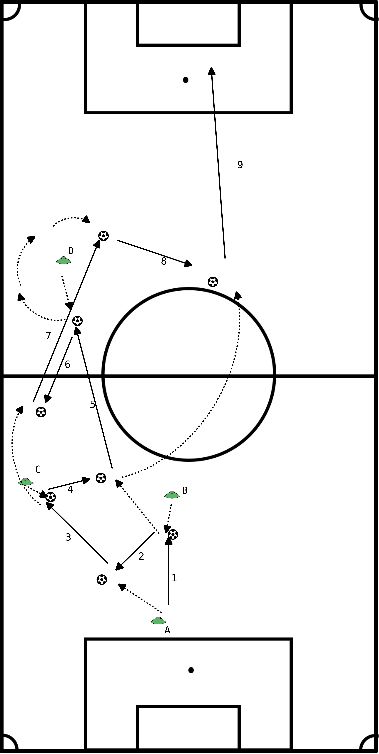
- Blue passes to red and then calls out where she/he wants the ball; left or right?
- Red passes and blue finishes.
